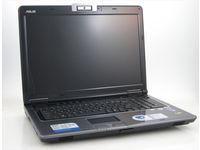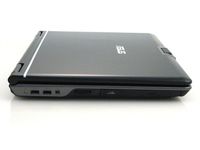Five Multimedia Notebooks, Tested
Asus M70S
Asus likes to position the M70S specifically as a multimedia notebook. That makes it very interesting since the review unit the company sent included a 1440x900 resolution monitor and a DVD burner, rather than a 1920x1200 WUXGA monitor with Blu-ray player, both of which are available as options for this particular notebook. At the time our unit was received, these notebooks were in very high demand, however. We only got to keep ours for a few weeks, then had to ship it back, presumably to make it available for other reviews.
Anybody who is serious about using this notebook for multimedia applications would be very well advised to purchase a properly equipped model like the one from DataVision for $2,300 rather than one equipped as ours was, like this $1,400 unit from Provantage.com. That said, we can only review the units that the vendor chooses to send us. At 9 pounds, the M70S is typical for a 17" notebook, while the AC adapter and cord add another 1.96 pounds to the load.
As equipped, our M70S was no slouch, though of course it suffered from its inability to play back Blu-ray media or to provide full 1080 resolution for HDTV playback. That said, it does include a decent set of Altec Lansing speakers and support for Dolby Home Theater playback, and its ATI Mobility Radeon HD 3650 graphics circuitry delivered good video playback and modest gaming support (as you’d expect on a multimedia unit that’s not aimed at hardcore gamers). Once again, we suffered from glossy surfaces inside and out (which explains why so many of these notebooks include microfiber cleaning cloths).
As delivered, the M70S we reviewed included an Intel Core 2 Duo 7700 with a 2.4 GHz clock speed (more expensive models feature a 2.5 GHz model instead) and 2 GB of DDR2-667 RAM (more expensive models usually include 4 GB, even though the OS and graphics circuitry drop usable RAM to around 3 GB). This unit included 1 TB of onboard storage, in the form of two 500 GB Hitachi 5400 rpm SATA 300 drives. It also included a Marvell Yukon GbE wired network interface and an Intel 4965 802.11a/g/n wireless interface as well.
Ports and connectors are the same for all M70S models, except, of course, that the optical drives will differ in what they can do. Check out the images for more details on what you’ll find on each side of the system.
The display deck also includes a built-in 1.3 Mpixel Webcam and a microphone at the inside top above the screen. Two stereo speakers are mounted on the keyboard deck above the keyboard (one to the left of the special media keys (aka "Instant Keys"), the other to the right of the indicator LEDs and start button). To the left of the LEDs, you’ll find an ambient light sensor that this notebook uses to adjust brightness and backlighting levels automatically (when power saving regimes permit). There’s also a fingerprint scanner available for M70S (it also performs facial recognition using the built-in camera as another biometric check), which is positioned at the bottom center of the keyboard deck, just below the touchpad.
Except for the lack of Blu-ray and a high-res monitor, and a somewhat underpowered CPU by comparison to the other notebooks reviewed here, the M70S showed itself to be a decent, capable and workmanlike notebook. However, if sufficiently tricked out, it would be much better able to compete with the other notebooks in this review.
Get Tom's Hardware's best news and in-depth reviews, straight to your inbox.
-
urimiel I am really sorry to be the one that points this out. I am Tomshardware reader for quite many years now. This is the first time I have seen an article or any kind of presentation like that. You guys are posting bar graphs and change the legend of each color bar for every different graph... this does not make sense.Reply -
fudgeboy ReplyYou guys are posting bar graphs and change the legend of each color bar for every different graph
wow, and thats like the basic fundamentals of presentation. the writers on this site really need to go back to high school. they should have a standard layout over the whole thing (like you would if you were doing an experiment) -
Master Exon Basically purple is always at the top, regardless of who purple represents. Kinda dumb, but they really should have had the manufacturer's name on the bar itself.Reply
Hey, when will TH compare $300-$450 netbooks? You already did the $2000 ones. -
cangelini urimielI am really sorry to be the one that points this out. I am Tomshardware reader for quite many years now. This is the first time I have seen an article or any kind of presentation like that. You guys are posting bar graphs and change the legend of each color bar for every different graph... this does not make sense.Reply
Heya guys--sorry about that. I should have caught this in editing. The charts are now correct with each notebook appearing in the same place with the same corresponding legend data. -
FrozenGpu Master ExonBasically purple is always at the top, regardless of who purple represents. Kinda dumb, but they really should have had the manufacturer's name on the bar itself.Hey, when will TH compare $300-$450 netbooks? You already did the $2000 ones.Reply
Pretty pretty please with a cherry on top? -
TheGreatGrapeApe To me the $300-450 laptops aren't worth an in depth review, just a quicky 2 pager (is it capable as a netbook yes/no) that's a disposable laptop you buy a kids or as a couch laptop or travel one.Reply
I want to know what my $2K+ buys me, the $300 laptop is the price of one of the options on these things. That's the bigger risk. What's anyone really expecting in a $300-400 laptop, certainly not heaving gsaming, video editing or programming.
It may seem elitist, but with the limited amount of info out there on laptops period, netbooks shouldn't consume much of the reviews time, nor space, I'd rather see more $1,000 and $2,000 and then $3,000+ reviews those 3 categories have more variability and value than the cheapest ones. Who can't figure out if a $400 laptop is worth it from a visit to the best buy or whatever?
Personally I want to see an IBM W700 review, tell me if it's worth the $3,000+ (is the built in Wacom pad good enough, the keyboard stiff enough, is it worth it to get turbo memory now that it's faster & bigger or just go SSD and be done with it, etc), not something to tell me which of the cheap laptops is slower than my previous laptops that you could buy at a discount store for as much and which might be just a tiny bit faster but still just suited for M$ office and websurfing and light photoshoping.
-
Is the image for this on the Toms Hardware site supposed to say "Multiedia" on the laptop screen or is that a typo?Reply
-
johntmosher I have been wanting to find a 20 inch laptop so I was excited to see the HDX review.....But still can't find it for sale online at HP.COMReply
Got a sales link? -
maric423 johntmosherI have been wanting to find a 20 inch laptop so I was excited to see the HDX review.....But still can't find it for sale online at HP.COMGot a sales link?Reply
According to the HP Sales guys, its out of production (I got interested and looked for it too). The replacement machine is supposedly the HP HDX 18t, which is only an 18.4", and doesn't have the same hinge structure. Not really a comparable machine. You can still find a few HP Pavilion HDX 20" from third parties if you search around, but I wasn't thrilled about the idea of buying a system they'd already stopped making. -
Can you please test one more little thing? Linux compatibility.Reply
Its easy, just toss in an ubuntu live CD, and tell us if things like sound, webcam, wifi etc work out of the box. If they don't, don't bother much trying to get it to work. But Acer for instance is notorious for having buggy ACPI implementation in the bios that detects the OS and only work with Vista. With Linux (possibly even XP) standby will be highly unreliable. Dell and IBM do a much better job at it, and that deserves to be known.
Doing such tests should be very straightforward and accomplish two things:
1) inform us linux users (we buy notebooks too you know :) )
2) put some pressure on oem's to test their BIOS and hardware with linux
Id appreciate it. No one does this, please be the first :)


